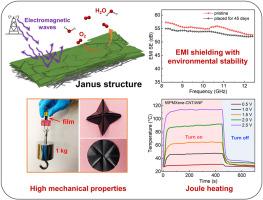Mechanically strong and environmentally stable MXene films reinforced by CNT-embedded aramid nanofibers for electromagnetic interference shielding
IF 9.8
1区 材料科学
Q1 MATERIALS SCIENCE, COMPOSITES
引用次数: 0
Abstract
Developing novel transition metal carbides/nitrides (MXene)-based electromagnetic interference (EMI) shielding composites with excellent mechanical properties and oxidation resistance is urgently demanded but remains hugely challenging thanks to the increasingly sophisticated application scenarios. Herein, we demonstrated an interfacial engineering and sequential assembling strategy to synergistically address the above problems. Carbon nanotubes (CNT) were utilized to assist the splitting preparation of aramid nanofibers (ANF) and chemical cross-linking to construct a substrate layer that served to provide mechanical properties. Polydopamine (PDA) was modified onto MXene surface (PMXene) by in situ polymerization and binding, generating an adhesive layer to prevent oxygen penetration effectively. The resultant Janus-structured PMXene-CNT/ANF films exhibited outstanding mechanical performances including high tensile strength (366.8 MPa) and toughness (69.3 MJ m−3), superb electrical conductivity (3548.8 S cm−1), impressive EMI shielding effectiveness (EMI SE 55.5 dB) and EMI SE/t (14128.2 dB cm−1), as well as excellent oxidation stability. Furthermore, the flexible films displayed distinguished Joule-heating performances and fast and sensitive temperature response at external voltage. Therefore, such composite films with excellent mechanical properties and environmental stability have great practical value in flexible electronics and military electronic equipment for EMI shielding, and the polar-exploration equipment for anti-icing and de-icing.

机械强度和环境稳定的MXene薄膜由碳纳米管嵌入芳纶纳米纤维增强,用于电磁干扰屏蔽
开发具有优异机械性能和抗氧化性能的新型过渡金属碳化物/氮化物(MXene)基电磁干扰(EMI)屏蔽复合材料是迫切需要的,但由于应用场景日益复杂,仍然具有巨大的挑战性。在此,我们展示了一种界面工程和顺序组装策略来协同解决上述问题。碳纳米管(CNT)被用于辅助芳纶纳米纤维(ANF)的分裂制备和化学交联,以构建提供机械性能的衬底层。通过原位聚合和结合将聚多巴胺(PDA)修饰在MXene表面(PMXene)上,形成一层有效阻止氧渗透的粘附层。所得到的janus结构PMXene-CNT/ANF薄膜具有出色的机械性能,包括高拉伸强度(366.8 MPa)和韧性(69.3 MJ m−3),卓越的导电性(3548.8 S cm−1),令人印象深刻的EMI屏蔽效果(EMI SE 55.5 dB)和EMI SE/t (14128.2 dB cm−1),以及出色的氧化稳定性。此外,柔性薄膜具有优异的焦耳加热性能和快速灵敏的外部电压温度响应。因此,这种具有优异力学性能和环境稳定性的复合薄膜在柔性电子和军用电子设备中屏蔽电磁干扰、极地探测设备防冰除冰等方面具有很大的实用价值。
本文章由计算机程序翻译,如有差异,请以英文原文为准。
求助全文
约1分钟内获得全文
求助全文
来源期刊

Composites Science and Technology
工程技术-材料科学:复合
CiteScore
16.20
自引率
9.90%
发文量
611
审稿时长
33 days
期刊介绍:
Composites Science and Technology publishes refereed original articles on the fundamental and applied science of engineering composites. The focus of this journal is on polymeric matrix composites with reinforcements/fillers ranging from nano- to macro-scale. CSTE encourages manuscripts reporting unique, innovative contributions to the physics, chemistry, materials science and applied mechanics aspects of advanced composites.
Besides traditional fiber reinforced composites, novel composites with significant potential for engineering applications are encouraged.
 求助内容:
求助内容: 应助结果提醒方式:
应助结果提醒方式:


